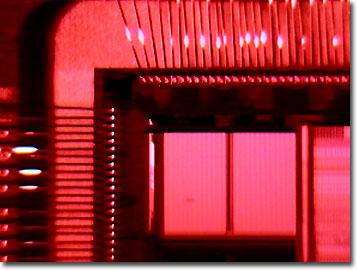Integrated Circuit Image Gallery
Advanced Micro Devices 486DX2 Microprocessor
As a worldwide quest for the computation crown continued into the fourth generation of PC-compatible microprocessors in the late 1980s, the 486 family grew with the use of internal clock doublers, triplers, and quadruplers creating the "speed demon" DX2s and DX4s. In March 1992, the 486DX2 was released with an external clock speed of just 25 MHz, but for its time, a lightning fast internal clock speed of 50 MHz.

Capable of 41 million instructions per second (MIPS) through a cadre of 1.2 million transistors, the DX2 chip was fabricated with 0.8-micron Bi-CMOS silicon technology on an 81-square millimeter die. Featured were 8 Kbytes of on-chip cache memory, 4 Gbytes of addressable memory, and an integral 80-bit floating-point unit. The 32-bit (internal register and external bus widths) central processing unit was followed up in August 1992 with the faster 66 MHz (internal clock speed) 486DX2 which operated on 5 volts. This processor had a peak power dissipation of 7.0 watts, but was more typically operated at 4.9 watts.
Applying the reverse engineering concept pioneered by the Japanese semiconductor industry, Advanced Micro Devices (AMD), a Silicon Valley semiconductor manufacturer, erected their microprocessor empire on the foundation of Intel's designs and leapfrogged ahead. Following their 286, 386, and 486 central processing units (CPUs), AMD released their 486DX2 in 1992 and the 486DX4 in 1994, as did fellow clone maker Cyrix. Built-in system management mode (SMM), power management, and write-back capability for the primary cache boosted performance on these 486DX2 designs. In addition, the cloned processors attained a maximum clock speed of 40 MHz that ran with an internal speed of 80 MHz. Although less expensive, many users believed that the clones were just as reliable as the name brand processors.
Contributing Authors
Omar Alvarado, Thomas J. Fellers and Michael W. Davidson - National High Magnetic Field Laboratory, 1800 East Paul Dirac Dr., The Florida State University, Tallahassee, Florida, 32310.
BACK TO THE INTEGRATED CIRCUIT IMAGE GALLERY
BACK TO THE DIGITAL IMAGE GALLERIES
Questions or comments? Send us an email.
© 1995-2022 by Michael W. Davidson and The Florida State University. All Rights Reserved. No images, graphics, software, scripts, or applets may be reproduced or used in any manner without permission from the copyright holders. Use of this website means you agree to all of the Legal Terms and Conditions set forth by the owners.
This website is maintained by our
Graphics & Web Programming Team
in collaboration with Optical Microscopy at the
National High Magnetic Field Laboratory.
Last Modification Friday, Nov 13, 2015 at 02:19 PM
Access Count Since September 17, 2002: 12560
Visit the website of our partner in introductory microscopy education:
|
|
